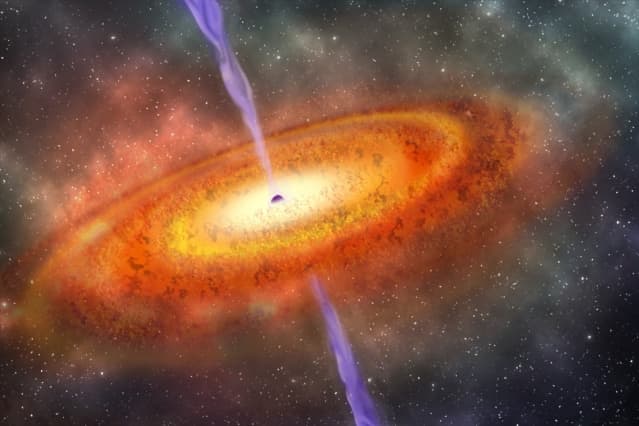Researchers found 800 million solar mass Black Hole hiding at the center of an ultra-bright Quasar
Researchers at Carnegie Institute of Sciences and MIT have found the greatest anomaly in the history of black hole discovery. They have discovered a giant supermassive black hole hidden in the center of an ultrabright quasar. The mass of the giant has been estimated to be around 800 times the mass of our sun and such black holes with such high interstellar masses rarely exist in the early universe. The research has been published in the journal #-Link-Snipped-# and can be found by accessing this #-Link-Snipped-#.

An artist's impression of the Supermassive Black Hole
The light from the ultrabright quasar under study was first released 690 million years after the big bang which makes it one of the potential candidates for unraveling the big bang mystery. The light coming out from the source took 13 billion years to reach earth which is nearly same to the age of our present universe. Scientists are concerned with this fact because it is anomalous to find such massive black holes in the early stage of the universe. They are studying more about this supergiant as it could contain the information about the star formation.
It is believed that previously the universe was at an equilibrium containing an equal proportion of neutral and ionized hydrogen atoms. During the period of the first-star formation, gravity caused these atoms to get concentrated and form the first star of the universe. Later photons coming out from these stars ionized the neutral hydrogen atoms thus initiating the formation of other stars. While studying the quasars, researchers found that most of the hydrogens present near it are neutral in nature and hence, concluded that the quasar has a connection with the early phases of star formation. The science involved in the star formation is still unknown to the scientific community and the quasar blackhole pair could be a suitable candidate to test possible theories.
FIRE - also known as the Folded-port InfraRed Echellette is a spectrometer which has been used to identify these supermassive distant objects. The researchers have relied on 'redshift' - a phenomenon similar to doppler shift that causes the spectrum of distant astronomical objects to appear far red in spectrum study. FIRE, which operates with the Magellan Telescopes in Chile have recorded a redshift of 7.5 which indicates and confirms the quasar's age and the mass of the black hole.
Identification of these quasar black hole pair has opened a new chapter in the science of black hole formation. According to the researchers, it is impossible to find such massive objects in the infant stage of our universe. Black holes increase in size by accrediting materials from nebulae and other sources. However, even then it is impossible for a black hole to attain such a massive mass in a period of 690 million years after big bang. The researchers are looking for a possible explanation and are planning to collect more information to investigate the science behind black hole formation.
Source - <a href="https://news.mit.edu/2017/scientists-observe-supermassive-black-hole-infant-universe-1206" target="_blank" rel="nofollow noopener noreferrer">news.mit.edu</a>

An artist's impression of the Supermassive Black Hole
The light from the ultrabright quasar under study was first released 690 million years after the big bang which makes it one of the potential candidates for unraveling the big bang mystery. The light coming out from the source took 13 billion years to reach earth which is nearly same to the age of our present universe. Scientists are concerned with this fact because it is anomalous to find such massive black holes in the early stage of the universe. They are studying more about this supergiant as it could contain the information about the star formation.
It is believed that previously the universe was at an equilibrium containing an equal proportion of neutral and ionized hydrogen atoms. During the period of the first-star formation, gravity caused these atoms to get concentrated and form the first star of the universe. Later photons coming out from these stars ionized the neutral hydrogen atoms thus initiating the formation of other stars. While studying the quasars, researchers found that most of the hydrogens present near it are neutral in nature and hence, concluded that the quasar has a connection with the early phases of star formation. The science involved in the star formation is still unknown to the scientific community and the quasar blackhole pair could be a suitable candidate to test possible theories.
FIRE - also known as the Folded-port InfraRed Echellette is a spectrometer which has been used to identify these supermassive distant objects. The researchers have relied on 'redshift' - a phenomenon similar to doppler shift that causes the spectrum of distant astronomical objects to appear far red in spectrum study. FIRE, which operates with the Magellan Telescopes in Chile have recorded a redshift of 7.5 which indicates and confirms the quasar's age and the mass of the black hole.
Identification of these quasar black hole pair has opened a new chapter in the science of black hole formation. According to the researchers, it is impossible to find such massive objects in the infant stage of our universe. Black holes increase in size by accrediting materials from nebulae and other sources. However, even then it is impossible for a black hole to attain such a massive mass in a period of 690 million years after big bang. The researchers are looking for a possible explanation and are planning to collect more information to investigate the science behind black hole formation.
Source - <a href="https://news.mit.edu/2017/scientists-observe-supermassive-black-hole-infant-universe-1206" target="_blank" rel="nofollow noopener noreferrer">news.mit.edu</a>
0
